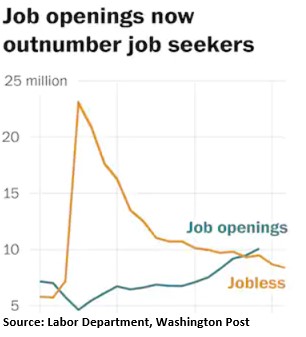Last Friday’s jobs report for August was a huge disappointment in terms of new jobs created. Ahead of the report, forecasters predicted there were 720,000 new jobs created last month. Yet the Labor Department reported there were only 235,000 new jobs added in the month, down from about 1 million new jobs created in June and in July.
That’s about as bad as it gets for report misses. Today let’s look at the possible reasons why.
While the number of new jobs created in August was a stunner, not all the news in the report was bad. The headline unemployment rate fell to 5.2% in August, down from 5.4% in July, which was encouraging. And average hourly wages rose 4.3% from this time a year ago, the Labor Department reported, also good.
But the lack of new jobs created in August greatly overshadowed the good news in the overall unemployment rate and the increase in wages. In the wake of the report, most forecasters said the lack of new jobs created last month must have been because many workers did not return to their jobs in August due to fears of the “Delta Variant” of the COVID-19 virus which is spreading widely. Maybe, but that is just speculation.
The overriding question in the jobs market is this: Why are unemployed workers not returning to the workforce? Is fear of the Delta Variant the main reason? I don’t think so.
According to the Labor Department, there are over 8 million unemployed workers in the US today who could take a job if they wanted to. The bigger number is the fact that there are nearly 11 million unfilled job openings which employers are desperate to fill, according to the latest Labor Department report.
 Not only that, workers are also quitting jobs at record rates. This may be due to the fact they know there are plenty of open jobs available, but I think there’s more to it than that. Something else is going on here.
Not only that, workers are also quitting jobs at record rates. This may be due to the fact they know there are plenty of open jobs available, but I think there’s more to it than that. Something else is going on here.
The question becomes even more perplexing when we consider the fact that expanded unemployment benefits from the federal government and the states – which paid many people as much or more than going back to work in many cases — have ended for millions of jobless workers in the last few weeks.
Some of these people went back to work recently, but millions still have not. There are still 5.4 million fewer jobs today than before the pandemic began in February of last year. Again, the question is why.
The answer lies in the fact there is a massive employment reallocation underway in the economy among both employees and employers — which is triggering what some economists call a “great reassessment” of work in America.
Workers are shifting where they want to work — and how. For some, this is a personal choice. The pandemic and all of the anxieties, lockdowns and time at home have changed people. Some want to work remotely forever. Others want to spend more time with family. And others want a more flexible or more meaningful career path.
It’s the “you only live once” mentality on steroids.
The reassessment is playing out in all facets of the labor market this year, as people make very different decisions about work than they did pre-pandemic. As noted above, resignations are the highest on record — up 13% over pre-pandemic levels. There are 4.9 million more people who aren’t working or looking for work than there were before the pandemic.
There’s also a surge in retirements with 3.6 million people retiring during the pandemic, over 2 million more than expected. At the same time, there’s been a boost in entrepreneurship which has caused the biggest jump in years in new business applications and incorporations.
It doesn’t help that the abundance of job openings this year are not in the same occupations — or same locations — where people worked pre-pandemic. There is a fundamental mismatch between what industries have the most job openings now and how many unemployed people used to work in that industry pre-pandemic.
For example, there are 1.8 million job openings in professional and business services but fewer than 925,000 people whose most recent job was in that sector. Leisure and hospitality, as well as retail and wholesale trade, also have more unfilled openings than prior workers with experience, and many workers who lost jobs in those industries have indicated they don’t want to return.
Nationwide, most industries have more job openings than people with prior experience in that sector. Companies across the economy are raising pay at a rapid pace in an effort to entice more people back to work. It’s helped, but the pandemic and reallocation pains are still significant barriers.
The bottom line is, the employment landscape, both for workers and employers, has changed significantly in the wake of the pandemic. Many workers are reassessing their prior careers and where they want to work in the future. Many employers are likewise reassessing what level and type of experience they require of new hires. Perhaps this explains in part why we have over 5 million fewer jobs today than before the pandemic arrived in early 2020. Hope this helps.


Sorry, comments are closed for this post.